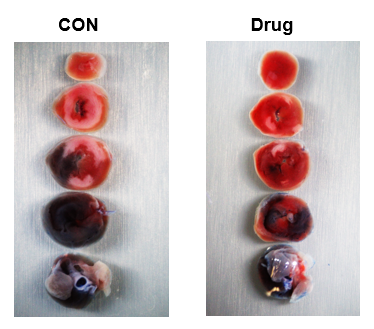Myocardial Ischemia-Reperfusion Injury (IRI)
IRI results from blood flow through the ischemic area, also known as reperfusion injury. IRI is a common complication after ischemic organs are rescued from prolonged ischemia such as a heart attack or stroke. The Myocardial IRI model was the first model we developed in 2006 and remains a popular animal model for drug development.
Myocardial IRI mimics the cardiac injury that can occur after bypass surgery or angioplasty following a myocardial infarction. The IRI animal model is induced by occluding the left coronary artery for a prolonged time period. The occlusion is then reopened to allow for reperfusion of the blood. Cardiac function can be reduced after Ischemia-Reperfusion Injury (IRI); however, myocardial injury can be attenuated by an effective treatment.
Experimental Protocol


Mice were subjected to 40-min ischemia and 24 hrs of reperfusion. Hearts were isolated and sectioned into five pieces. TTC stained live tissue red. Infarcted tissue remained white. Non-ischemic tissue was stained by Evans blue.




